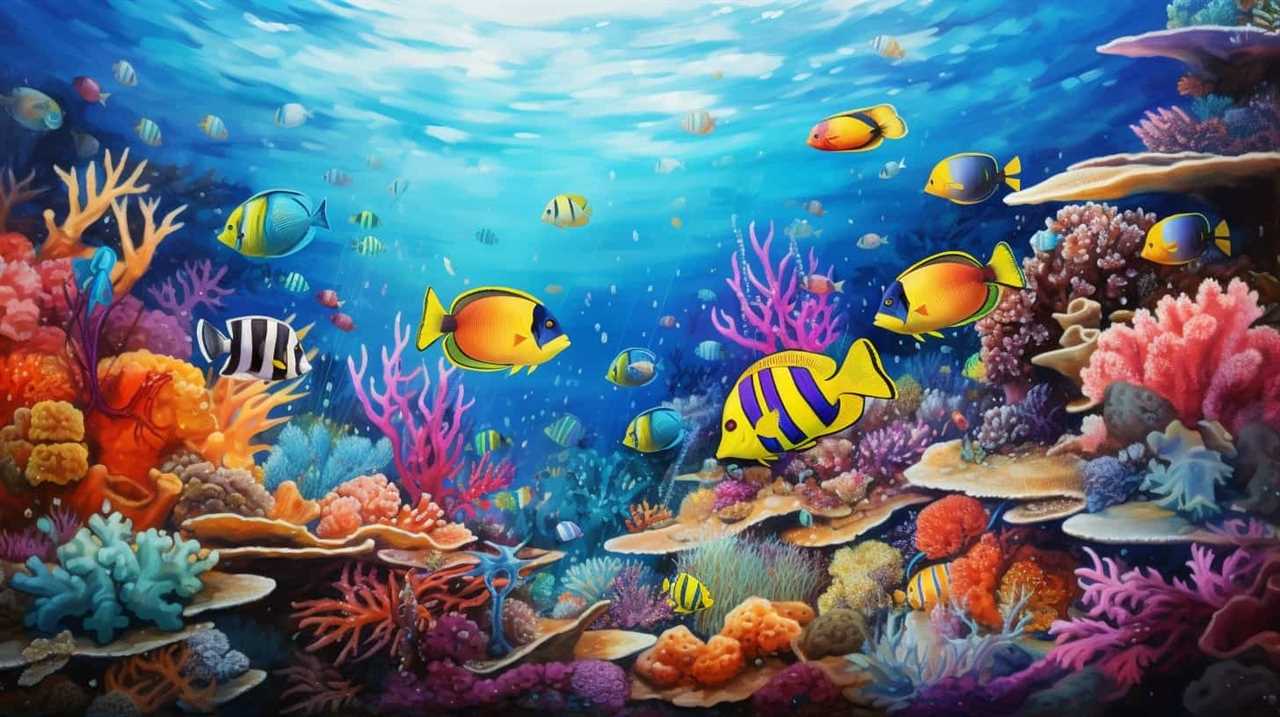We have discovered the perfect way to reveal the secrets of the ocean’s harmony.
In our curated guide to sea acoustics, we reveal the techniques that will amaze and inspire.
From choosing the right microphone to understanding underwater acoustics, we provide the tools you need to capture the captivating sounds of the sea.
Dive into our world of amplifying and recording, where innovation and precision combine to create a truly immersive experience.

Get ready to embark on an extraordinary journey into the realm of ocean acoustics.
Key Takeaways
- Understanding microphone selection and placement is crucial for optimal recording results.
- Understanding underwater acoustics is essential for improving communication systems and conservation efforts.
- Proper setup of recording equipment, including hydrophones and waterproof devices, is necessary for accurate sound capture.
- Techniques such as strategic hydrophone placement, signal processing algorithms, and sound frequency analysis contribute to the study and conservation of marine life.
Choosing the Right Microphone
When it comes to amplifying and recording sea acoustics, we need to start by considering the importance of choosing the right microphone.
The success of capturing accurate underwater sound relies heavily on the microphone types and their proper placement. There are various microphone types available in the market, each designed to cater to specific underwater recording needs. For instance, hydrophones are ideal for capturing low-frequency sounds, while electret condenser microphones excel at recording higher frequencies.
Additionally, the placement of the microphone plays a crucial role in capturing clear and precise underwater audio. Placing the microphone near the source of the sound and minimizing any obstructions can significantly enhance the quality of the recorded acoustics.

Understanding the principles of microphone selection and placement is crucial in achieving optimal results when recording and amplifying sea acoustics.
Now, let’s delve into the subsequent section to further explore the fascinating world of underwater acoustics.
Understanding Underwater Acoustics
To understand underwater acoustics, we must explore the fundamental principles of sound propagation in the marine environment. Sound in water travels differently than in air due to the unique properties of the marine medium. Water is denser and more efficient at transmitting sound waves, allowing them to travel greater distances. Understanding how sound behaves underwater is crucial for improving underwater communication systems and studying marine mammal behavior.
Underwater communication and the study of marine mammal sounds have become increasingly important in recent years. By analyzing the frequency, amplitude, and duration of marine mammal sounds, researchers can gain insights into their communication patterns and behaviors. This knowledge can lead to the development of innovative technologies for underwater communication and conservation efforts.

Setting up the Recording Equipment
We start by familiarizing ourselves with the necessary equipment for recording underwater sounds.
To capture marine life sounds with accuracy and clarity, the following items are essential:
-
Underwater microphone: Also known as a hydrophone, this specialized microphone is designed to capture sound waves underwater. It’s built to withstand the harsh marine environment while providing high-fidelity recordings.
-
Recording device: A waterproof and durable recording device is required to store and process the audio signals captured by the underwater microphone. It should have sufficient storage capacity and be able to handle long recording sessions.

-
Cable and connectors: High-quality cables and connectors are necessary to ensure a reliable and interference-free connection between the underwater microphone and the recording device. They should be resistant to water damage and capable of transmitting the subtle nuances of the captured sounds accurately.
Properly setting up the recording equipment is crucial for capturing the intricate sounds of marine life and exploring the depths of the underwater world.
Techniques for Amplifying Ocean Sounds
Now, let’s explore methods for enhancing the volume of ocean sounds using specialized techniques.
Underwater noise pollution poses a significant challenge in capturing marine mammal sounds, as it can mask or distort the desired signals. To overcome this, hydrophones can be used to amplify and record ocean sounds with precision. These devices are designed to detect and convert underwater acoustic waves into electrical signals.

By strategically placing hydrophones at different depths and locations, researchers can effectively capture and amplify marine mammal sounds while minimizing background noise. Additionally, advanced signal processing algorithms can be employed to further enhance the volume and clarity of these recordings.
These techniques not only enable a more accurate representation of ocean soundscapes but also contribute to the study and conservation of marine life.
Editing and Enhancing Ocean Recordings
In our exploration of sea acoustics, we’ll now delve into the process of editing and enhancing ocean recordings through the use of specialized techniques.
When working with audio recordings of the ocean, it’s crucial to ensure that the sound is clean and free from unwanted noise. This can be achieved through various methods, such as filtering out background noise and removing any artifacts or disturbances in the recording.

Analyzing sound frequencies is another essential step in editing and enhancing ocean recordings. By examining the different frequencies present in the recording, we can identify and isolate specific sounds of interest, allowing for a more precise and focused listening experience.
Additionally, analyzing sound frequencies can provide valuable insights into the behavior and communication patterns of marine life.
Frequently Asked Questions
How Long Can a Microphone Be Immersed in Water Before It Gets Damaged?
Maximum depth at which a microphone can be immersed in water before damage occurs depends on its waterproof capabilities. Waterproof microphone options are available for various depths, allowing innovative underwater recording and amplification in sea acoustics research.
What Are the Best Locations for Recording Underwater Sounds in the Ocean?
To capture the depth and clarity of underwater sounds, we must consider the best equipment for recording in the ocean. Our guide, "Amplifying and Recording: A Curated Guide to Sea Acoustics," explores techniques for optimal recordings.

How Can I Reduce the Background Noise in My Ocean Recordings?
To reduce background noise in our ocean recordings, we can utilize advanced underwater microphone technology and employ effective techniques for noise cancellation. This ensures precise and clear audio capture, enhancing the quality of our recordings.
Are There Any Specific Safety Precautions I Should Take When Setting up Recording Equipment in the Ocean?
When setting up recording equipment in the ocean, it is crucial to take specific safety precautions. We must ensure the necessary equipment is in place to protect against potential hazards and maintain optimal recording conditions.
What Are Some Common Challenges Faced When Editing and Enhancing Ocean Recordings?
Improving clarity and enhancing marine biodiversity are key challenges in editing and enhancing ocean recordings. We employ innovative techniques to remove background noise, optimize frequency ranges, and ensure accurate representation of underwater soundscapes.
Conclusion
In conclusion, this curated guide has provided valuable insights into amplifying and recording ocean sounds.

By choosing the right microphone and understanding underwater acoustics, one can effectively capture the mesmerizing symphony of the sea.
With proper equipment setup and techniques, the recordings can be enhanced and edited to reveal the intricate details of marine life.
Exploring the depths of sea acoustics opens up a world of knowledge and fascination, allowing us to dive into the scientific wonders of our oceans.










